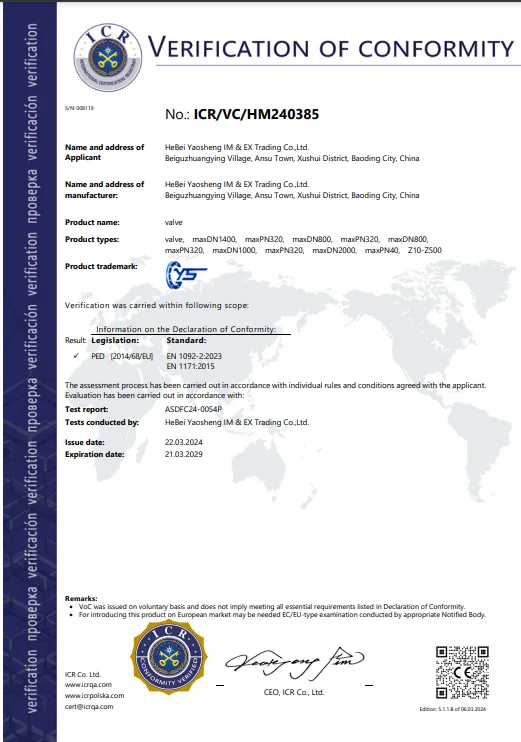4 inch gate valve specifications and applications in various industries and systems
Understanding the 4-Inch Gate Valve A Key Component in Fluid Control
In the world of plumbing and fluid control systems, valves serve the crucial role of managing the flow of liquids and gases through pipelines. Among the various types of valves available, the 4-inch gate valve stands out due to its reliability, durability, and effectiveness in controlling fluid flow. This article explores the features, applications, advantages, and installation considerations of the 4-inch gate valve.
What is a Gate Valve?
A gate valve is a type of linear valve that opens by lifting a round or rectangular gate away from the flow. It is primarily used to start or stop fluid flow, making it an on/off valve rather than a throttling device. The gate valve operates through a simple mechanism that allows for minimal restriction to flow when fully open, thus facilitating the smooth passage of liquids or gases.
Features of a 4-Inch Gate Valve
The 4-inch designation refers to the valve's nominal pipe size, which indicates that it is designed to fit in a 4-inch diameter pipeline. This size is commonly used in both residential and industrial applications. Here are some key features of a 4-inch gate valve
1. Material Gate valves are typically made from various materials such as brass, stainless steel, or cast iron, depending on the application. These materials provide resistance to corrosion and wear, ensuring longevity.
2. Design The design of a gate valve often includes a rising stem, meaning the stem rises and falls with the gate, indicating the valve's open or closed status visibly. Alternatively, some models are designed with a non-rising stem, which is advantageous in applications with limited vertical space.
3. Pressure and Temperature Ratings A 4-inch gate valve can be rated for specific pressure and temperature conditions, catering to different operational environments. It is essential to choose a valve that meets the requirements of the system it is intended for.
Applications of 4-Inch Gate Valves
4-inch gate valves are versatile and find applications in various sectors, including
- Water Distribution Often used in municipal water supply systems, these valves control the flow of water in pipes, ensuring efficient distribution and maintaining water pressure. - Industrial Processes In chemical plants and manufacturing facilities, gate valves manage the flow of raw materials and finished products, making them crucial for operational efficiency.
- Fire Protection Systems Gate valves play a critical role in fire sprinkler systems, enabling firefighters to quickly shut off or regulate water supply during emergencies.
4 inch gate valve

Advantages of Using a 4-Inch Gate Valve
There are several advantages to using a 4-inch gate valve
1. Low Flow Resistance When fully open, a gate valve provides minimal resistance to flow, making it ideal for high-capacity applications.
2. Durability With proper maintenance, gate valves can have a long service life, as they are designed to withstand high pressures and temperatures.
3. Sealing Capability Gate valves can provide a tight seal when closed, preventing leaks in the pipeline and protecting the system's integrity.
4. Ease of Operation The simple handwheel or actuator used to operate a gate valve allows for easy control over the fluid flow.
Installation Considerations
When installing a 4-inch gate valve, it is important to consider several factors
- Orientation Ensure that the valve is installed in the correct orientation according to the manufacturer's specifications, which typically indicate that the valve should be installed in a horizontal position.
- Sealing and Gaskets Use appropriate sealing materials and gaskets to prevent leaks during installation.
- Space Requirements Consider the space needed for the valve's operation and maintenance, especially if it has a rising stem design.
In conclusion, the 4-inch gate valve is an essential component in many fluid control systems, offering reliability and efficiency in managing fluid flow. Its versatile applications, combined with the advantages of durability, low resistance, and excellent sealing capabilities, make it a preferred choice for engineers and facility managers alike. Proper installation and maintenance can further enhance the performance and lifespan of this vital valve.
-
The Key to Fluid Control: Exploring the Advantages of Ball Valves in Industrial SystemsNewsJul.09,2025
-
The Versatile World of 1, 2, and 3 Piece Ball ValvesNewsJul.09,2025
-
Stainless Steel Ball Valves: The Ideal Choice for Efficient Flow ControlNewsJul.09,2025
-
Optimizing Fluid Control with Ball Float ValvesNewsJul.09,2025
-
Manual Gate Valves: Essential for Control and EfficiencyNewsJul.09,2025
-
Everything You Need to Know About Butterfly ValvesNewsJul.09,2025
-
The Versatility of Wafer Type Butterfly ValvesNewsJul.08,2025




